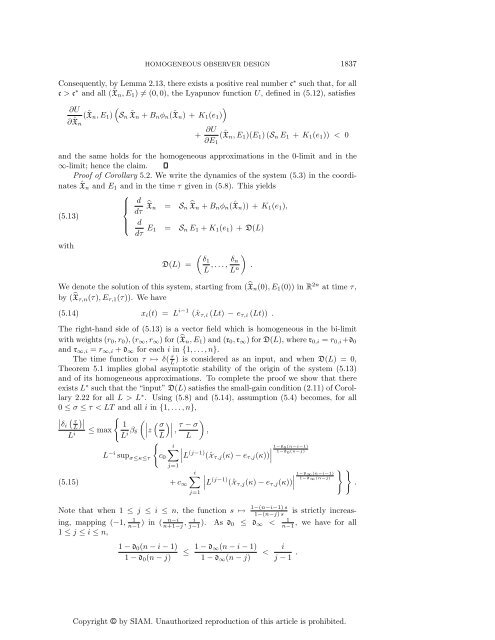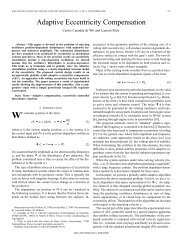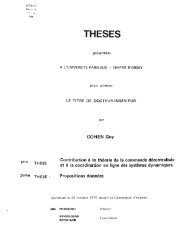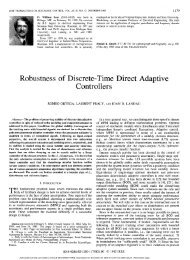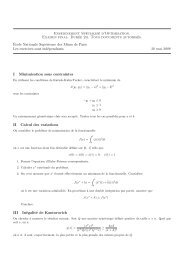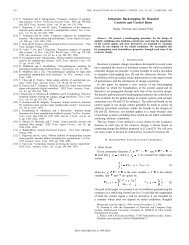Copyright © by SIAM. Unauthorized reproduction of this article is ...
Copyright © by SIAM. Unauthorized reproduction of this article is ...
Copyright © by SIAM. Unauthorized reproduction of this article is ...
You also want an ePaper? Increase the reach of your titles
YUMPU automatically turns print PDFs into web optimized ePapers that Google loves.
HOMOGENEOUS OBSERVER DESIGN 1837Consequently, <strong>by</strong> Lemma 2.13, there ex<strong>is</strong>ts a positive real number c ∗ such that, for allc > c ∗ and all (ˆX n ,E 1 ) ≠ (0, 0), the Lyapunov function U, defined in (5.12), sat<strong>is</strong>fies∂U()∂ ˆX(ˆX n ,E 1 ) S n ˆXn + B n φ n (ˆX n )+K 1 (e 1 )n+ ∂U∂E 1(ˆX n ,E 1 )(E 1 )(S n E 1 + K 1 (e 1 )) < 0and the same holds for the homogeneous approximations in the 0-limit and in the∞-limit; hence the claim.Pro<strong>of</strong> <strong>of</strong> Corollary 5.2. We write the dynamics <strong>of</strong> the system (5.3) in the coordinatesˆX n and E 1 and in the time τ given in (5.8). Th<strong>is</strong> yields(5.13)with⎧⎪⎨⎪⎩ddτ ̂X n = S n ̂Xn + B n φ n (ˆX n )) + K 1 (e 1 ),ddτ E 1 = S n E 1 + K 1 (e 1 )+D(L)(δ1D(L) =L ,..., δ )nL n .We denote the solution <strong>of</strong> <strong>th<strong>is</strong></strong> system, starting from (̂X n (0),E 1 (0)) in R 2n at time τ,<strong>by</strong> (̂X τ,n (τ),E τ,1 (τ)). We have(5.14) x i (t) = L i−1 (ˆX τ,i (Lt) − e τ,i (Lt)) .The right-hand side <strong>of</strong> (5.13) <strong>is</strong> a vector field which <strong>is</strong> homogeneous in the bi-limitwith weights (r 0 ,r 0 ), (r ∞ ,r ∞ ) for (̂X n ,E 1 ) and (r 0 , r ∞ ) for D(L), where r 0,i = r 0,i +d 0and r ∞,i = r ∞,i + d ∞ for each i in {1,...,n}.The time function τ ↦→ δ( τ L) <strong>is</strong> considered as an input, and when D(L) = 0,Theorem 5.1 implies global asymptotic stability <strong>of</strong> the origin <strong>of</strong> the system (5.13)and <strong>of</strong> its homogeneous approximations. To complete the pro<strong>of</strong> we show that thereex<strong>is</strong>ts L ∗ such that the “input” D(L) sat<strong>is</strong>fies the small-gain condition (2.11) <strong>of</strong> Corollary2.22 for all L>L ∗ . Using (5.8) and (5.14), assumption (5.4) becomes, for all0 ≤ σ ≤ τ < LT and all i in {1,...,n},∣ δi( τL)∣ ∣L i{ (1 ∣∣∣z ( σ)∣ )∣∣≤ maxL i β τ − σδ , ,L L{i∑L −i ∣sup σ≤κ≤τ ∣L (j−1) (ˆX τ,j(κ) − e τ,j (κ)) ∣c 0j=11−d 0 (n−i−1)1−d 0 (n−j)i∑∣(5.15) + c ∞ ∣L (j−1) (ˆX τ,j(κ) − e τ,j (κ)) ∣Note that when 1 ≤ j ≤ i ≤ n, the function s ↦→ 1−(n−i−1) s1−(n−j) s<strong>is</strong> strictly increas-n−i) in (n+1−j , ij−1 ). As d 0 ≤ d ∞ < 1n−1, we have for all1ing, mapping (−1,1 ≤ j ≤ i ≤ n,n−1j=11−d∞(n−i−1)1−d∞(n−j)}}1 − d 0 (n − i − 1)1 − d 0 (n − j)≤ 1 − d ∞(n − i − 1)1 − d ∞ (n − j)


